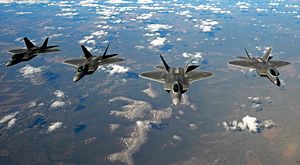The U.S. Air Force (USAF) scrambled fighter jets to intercept two Russian Ilyushin Il-38 “Dolphin” maritime patrol and anti-submarine warfare aircraft entering the Alaskan Air Defense Identification Zone (ADIZ) on April 8, North American Aerospace Defense Command (NORAD) said in a statement.
The Russian aircraft were reportedly intercepted by USAF F-22 Raptors in the Bering Sea, north of the Aleutian Islands, and did not enter U.S. or Canadian sovereign airspace.
The USAF fighters were supported by a Boeing E-3 Sentry airborne early warning and control (AEW&C) aircraft and a KC-135 Stratotanker.
“COVID-19 or not, NORAD continues actively watching for threats and defending the homelands 24 hours a day, 7 days a week, 365 days a year,” said General Terrence J. O’Shaughnessy, the NORAD commander. “This is the latest of several occasions in the past month in which we have intercepted Russian aircraft operating near the approaches to our nations. We continue to execute our no-fail homeland defense missions with the same capability and capacity we always bring to the fight.”
As I explained elsewhere, the Russian Il-38 first entered service over four decades ago:
The Il-38 and Il-38N are derivatives of the four-engined turboprop Ilyushin Il-18 transport aircraft, used as a maritime patrol aircraft in the Soviet Navy. The Il-38 first entered service in the 1970s.
The Il-38N is an improved variant of the original Il-38 and has reportedly been retrofitted with the new Novella maritime surveillance mission system, which enhances the aircraft’s electronic reconnaissance and tracking capabilities.
In addition to Ilyushin Il-38 and upgraded Ilyushin Il-38N planes, Russian naval aviation in the Far East deploys the Tupolev Tu-142 maritime reconnaissance and anti-submarine warfare aircraft for anti-submarine warfare missions. I explained previously:
The latest variant of the Tu-142 currently in service with Russian Naval Aviation, the Tupolev Tu-142MZ reportedly features a modern avionics suite, advanced anti-submarine warfare equipment, and new NK-12MP engines.
The Russian Navy deploys around 14 Tu-142MZ aircraft, although it is unclear how many of them are operational and flightworthy. Overall, the Russian Naval Aviation inventory of Tu-142s of all variants consists of approximately 24 aircraft.
In March, (USAF) and Royal Canadian Air Force (RCAF) scrambled fighter jets to intercept two Russian Tupolev Tu-142MZ maritime reconnaissance and anti-submarine warfare aircraft that entered the off the coast of Alaska
Two Tupolev Tu-142MZ aircraft of the Russian Pacific Fleet also entered the Alaskan ADIZ at the beginning of August 2019. That same month, the USAF and RCAF also intercepted two Russian Tupolev Tu-95 strategic bombers off the coast of Alaska.

































